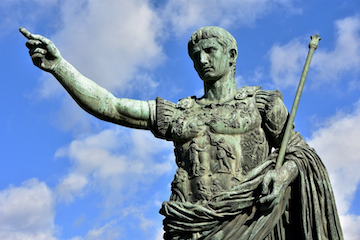
Roman Emperor. The supreme ruler and monarchical head of state of the Roman Empire, beginning with Augustus (Octavian) in 27 BC. The title and office evolved over centuries, with the emperor wielding ultimate authority over the military, government, and religion of Rome.
Titles and Styles
- Imperator: Originally a military honorific for victorious generals, it became a core imperial title denoting supreme command1.
- Augustus: First awarded to Octavian, it became the main honorific for emperors, symbolizing elevation and near-divinity12.
- Caesar: Initially a family name, it became a title for heirs and junior emperors.
- Princeps: Meaning “first citizen” or “first among equals,” used by early emperors to maintain a façade of republicanism12.
- Dominus Noster: “Our Lord,” a style adopted in the later empire.
- Basileus/Autokrator: Greek titles used especially in the Eastern Empire, denoting king and autocrat, respectively1.
Origins and Evolution
- The title “emperor” is a modern convention. Romans referred to their ruler by a variety of titles depending on period and context1.
- Augustus established the Principate, a system where the emperor maintained the appearance of republican governance while holding ultimate power.
- Over time, emperors became more openly monarchical and authoritarian, especially after Diocletian’s reforms in the late 3rd century, which introduced the Tetrarchy—a system of joint rule by multiple emperors.
- The division of the empire into Western and Eastern halves became permanent, with the Eastern emperors (Byzantine) continuing the tradition until the fall of Constantinople in 1453.
Legitimacy and Succession
- Legitimacy depended on control of the military and recognition by the Senate.
- Emperors were often proclaimed by their troops or the Senate, and sometimes ruled alongside co-emperors to secure succession or manage administration.
- The process of succession varied, including hereditary transfer, adoption, military acclamation, or usurpation.
Key Historical Periods
| Period | Description | Notable Emperors |
|---|---|---|
| Principate | 27 BC – 284 AD: Facade of republicanism, “first citizen” | Augustus, Nero, Trajan |
| Dominate | 284 AD onward: Open monarchy, divine kingship | Diocletian, Constantine |
| Tetrarchy | Rule by two senior and two junior emperors | Diocletian, Maximian |
| Byzantine | Eastern Empire, Greek titles, until 1453 | Justinian, Heraclius |
Legacy
The Roman emperor became a model for later European monarchs, influencing titles, court rituals, and concepts of sovereignty. The legacy of the Roman imperial system persisted in both the Holy Roman Empire and the Byzantine Empire.
List of Emperors
[draft]